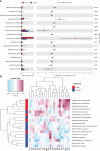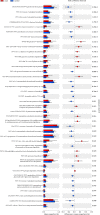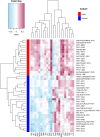Gut microbiome is associated with metabolic syndrome accompanied by elevated gamma-glutamyl transpeptidase in men
- PMID: 35967853
- PMCID: PMC9373028
- DOI: 10.3389/fcimb.2022.946757
Gut microbiome is associated with metabolic syndrome accompanied by elevated gamma-glutamyl transpeptidase in men
Abstract
It is predicted that by 2035, metabolic syndrome (MS) will be found in nearly more than half of our adult population, seriously affecting the health of our body. MS is usually accompanied by the occurrence of abnormal liver enzymes, such as elevated gamma-glutamyl transpeptidase (GGT). More and more studies have shown that the gut microbiota is involved in MS; however, the correlation between gut microbiota and MS with elevated GGT has not been studied comprehensively. Especially, there are few reports about its role in the physical examination of the population of men with MS and elevated GGT. By using the whole-genome shotgun sequencing technology, we conducted a genome-wide association study of the gut microbiome in 66 participants diagnosed as having MS accompanied by high levels of GGT (case group) and 66 participants with only MS and normal GGT level (control group). We found that the number of gut microbial species was reduced in participants in the case group compared to that of the control group. The overall microbial composition between the two groups is of significant difference. The gut microbiota in the case group is characterized by increased levels of "harmful bacteria" such as Megamonas hypermegale, Megamonas funiformis, Megamonas unclassified, Klebsiella pneumoniae, and Fusobacterium mortiferum and decreased levels of "beneficial bacteria" such as Faecalibacterium prausnitzii, Eubacterium eligens, Bifidobacterium longum, Bifidobacterium pseudocatenulatum, Bacteroides dorei, and Alistipes putredinis. Moreover, the pathways of POLYAMSYN-PWY, ARG+POLYAMINE-SYN, PWY-6305, and GOLPDLCAT-PWY were also increased in the case group, which may play a role in the elevation of GGT by producing amine, polyamine, putrescine, and endogenous alcohol. Taken together, there are apparent changes in the composition of the gut microbiome in men with MS and abnormal GGT levels, and it is high time to discover specific gut microbiome as a potential therapeutic target in that population. More in-depth studies of relevant mechanism could offer some new methods for the treatment of MS with elevated GGT.
Keywords: endogenous alcohol; glutamyl transpeptidase; gut microbiota; metabolic pathway; metabolic syndrome; metagenomics; polyamine.
Copyright © 2022 Sheng, Yan, Chen, Zhang, Wang, Qin, Li, Li, Huang, Ding and Tang.
Conflict of interest statement
The authors declare that the research was conducted in the absence of any commercial or financial relationships that could be construed as a potential conflict of interest.
Figures






Similar articles
-
Gut microbiome associated with APC gene mutation in patients with intestinal adenomatous polyps.Int J Biol Sci. 2020 Jan 1;16(1):135-146. doi: 10.7150/ijbs.37399. eCollection 2020. Int J Biol Sci. 2020. PMID: 31892851 Free PMC article.
-
Gamma-glutamyl transpeptidase level associated with metabolic syndrome and proinflammatory parameters in the young Roma population in eastern Slovakia: a population-based study.Cent Eur J Public Health. 2014 Mar;22 Suppl:S43-50. doi: 10.21101/cejph.a3901. Cent Eur J Public Health. 2014. PMID: 24847614
-
The relationship of Megamonas species with nonalcoholic fatty liver disease in children and adolescents revealed by metagenomics of gut microbiota.Sci Rep. 2022 Dec 20;12(1):22001. doi: 10.1038/s41598-022-25140-2. Sci Rep. 2022. PMID: 36539432 Free PMC article.
-
Serum Gamma Glutamyl Transferase: Understanding its Contribution as a Potential Predictor of the Occurrence of Type 2 Diabetes.Curr Diabetes Rev. 2024;21(1):e240124226080. doi: 10.2174/0115733998260996231122054907. Curr Diabetes Rev. 2024. PMID: 38275034 Review.
-
Understanding the Role of the Gut Microbiome and Microbial Metabolites in Non-Alcoholic Fatty Liver Disease: Current Evidence and Perspectives.Biomolecules. 2021 Dec 31;12(1):56. doi: 10.3390/biom12010056. Biomolecules. 2021. PMID: 35053205 Free PMC article. Review.
Cited by
-
A metagenomic approach to unveil the association between fecal gut microbiota and short-chain fatty acids in diarrhea caused by diarrheagenic Escherichia coli in children.Microb Cell. 2024 Apr 30;11:116-127. doi: 10.15698/mic2024.04.820. eCollection 2024. Microb Cell. 2024. PMID: 38799407 Free PMC article.
-
Relationships and Mendelian Randomization of Gut Microbe-Derived Metabolites with Metabolic Syndrome Traits in the METSIM Cohort.Metabolites. 2024 Mar 20;14(3):174. doi: 10.3390/metabo14030174. Metabolites. 2024. PMID: 38535334 Free PMC article.
-
Ruminococcus gnavus in the gut: driver, contributor, or innocent bystander in steatotic liver disease?FEBS J. 2025 Mar;292(6):1252-1264. doi: 10.1111/febs.17327. Epub 2024 Nov 26. FEBS J. 2025. PMID: 39589934 Free PMC article. Review.
-
Excess fermentation and lactic acidosis as detrimental functions of the gut microbes in treatment-naive TB patients.Front Cell Infect Microbiol. 2024 Feb 19;14:1331521. doi: 10.3389/fcimb.2024.1331521. eCollection 2024. Front Cell Infect Microbiol. 2024. PMID: 38440790 Free PMC article.
-
Gut microbiota involvement in the effect of water-soluble dietary fiber on fatty liver and fibrosis.Biosci Microbiota Food Health. 2025;44(1):49-57. doi: 10.12938/bmfh.2024-046. Epub 2024 Aug 21. Biosci Microbiota Food Health. 2025. PMID: 39764489 Free PMC article.
References
-
- Aleman J. O., Bokulich N. A., Swann J. R., Walker J. M., De Rosa J. C., Battaglia T., et al. . (2018). Fecal microbiota and bile acid interactions with systemic and adipose tissue metabolism in diet-induced weight loss of obese postmenopausal women. J. Transl. Med. 16 (1), 244. doi: 10.1186/s12967-018-1619-z - DOI - PMC - PubMed
-
- Anhe F. F., Roy D., Pilon G., Dudonne S., Matamoros S., Varin T. V., et al. . (2015). A polyphenol-rich cranberry extract protects from diet-induced obesity, insulin resistance and intestinal inflammation in association with increased akkermansia spp. population in the gut microbiota of mice. Gut 64 (6), 872–883. doi: 10.1136/gutjnl-2014-307142 - DOI - PubMed
Publication types
MeSH terms
Substances
LinkOut - more resources
Full Text Sources
Medical
Miscellaneous

